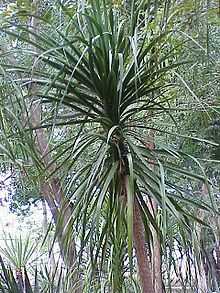Beaucarnea
| Beaucarnea | |
|---|---|
 | |
| Beaucarnea pliabilis | |
| Scientific classification | |
| Kingdom: | Plantae |
| Clade: | Angiosperms |
| Clade: | Monocots |
| Order: | Asparagales |
| Family: | Asparagaceae |
| Subfamily: | Nolinoideae |
| Genus: | Beaucarnea Lem. |
| Species | |
|
See text | |
Beaucarnea is a genus of four species of flowering plant native to Mexico, Belize and Guatemala. In the APG III classification system, it is placed in the family Asparagaceae, subfamily Nolinoideae (formerly the family Ruscaceae[1]). Beaucarnea is sometimes treated as a synonym of the genus Nolina, with the four species being then transferred to that genus.
The species are small tropical xerophytic trees growing to 6-10 m tall, with a trunk 20-40 cm diameter with a flared base; young plants are single-stemmed, branching only after flowering. The leaves are evergreen, linear, strap-shaped, 0.5-1.8 m long and 1.5-2 cm broad, leathery in texture, with a finely serrated margin. The flowers are produced only on old trees, forming on large panicles 75-110 cm long, the individual flowers numerous but very small (1.5 mm diameter), greenish-white, with six tepals.
- Selected species
- Beaucarnea gracilis (syn. B. oedipus, Nolina gracilis)
- Beaucarnea guatemalensis (syn. Nolina guatemalensis)
- Beaucarnea pliabilis
- Beaucarnea recurvata (syn. Nolina recurvata) - the species most commonly seen in cultivation
References
- ↑ Chase, M.W.; Reveal, J.L. & Fay, M.F. (2009), "A subfamilial classification for the expanded asparagalean families Amaryllidaceae, Asparagaceae and Xanthorrhoeaceae", Botanical Journal of the Linnean Society 161 (2): 132–136, doi:10.1111/j.1095-8339.2009.00999.x
- The Beaucarnea-Calibanus Page of the National University of Mexico: photographs of the species in the wild
- Germplasm Resources Information Network: Beaucarnea
- New York Botanic Garden: Beaucarnea pliabilis